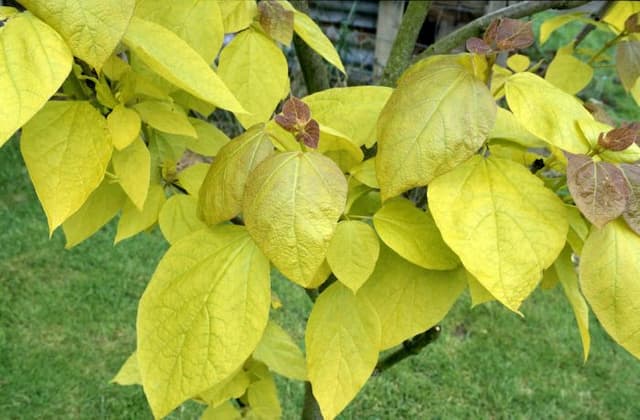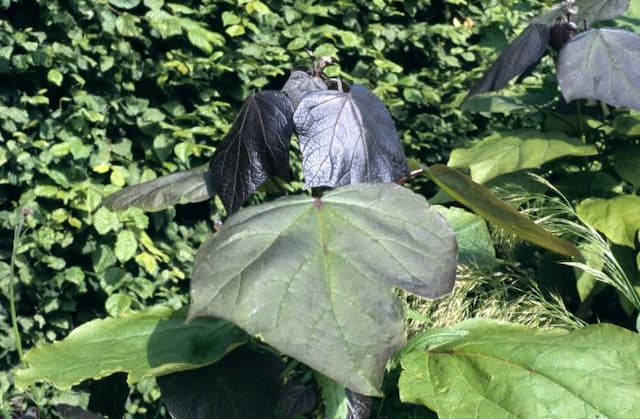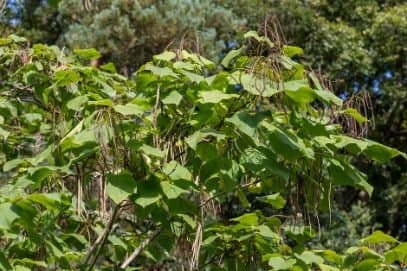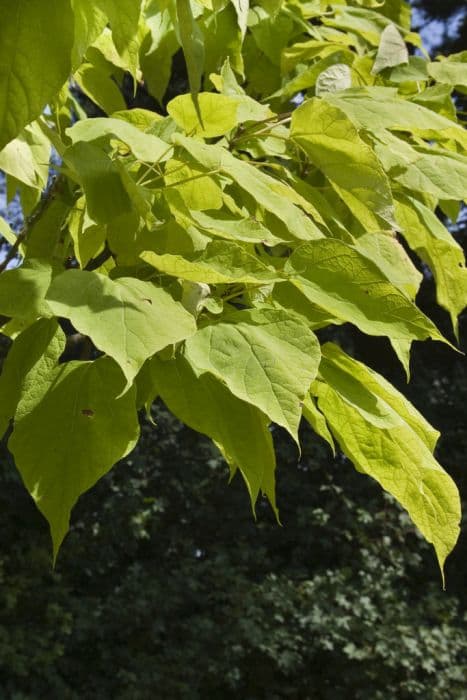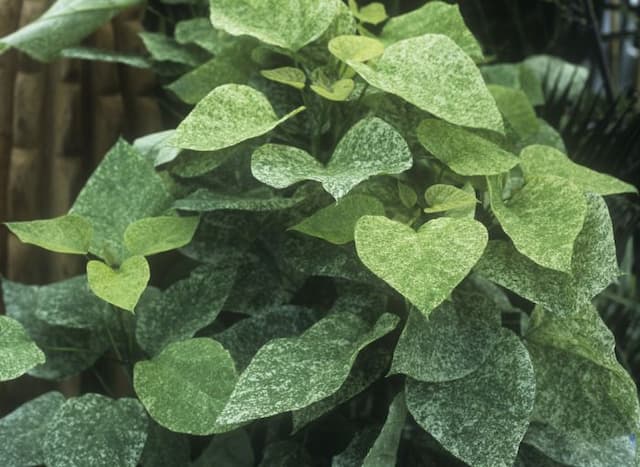Yellow Trumpet Vine Campsis radicans f. flava
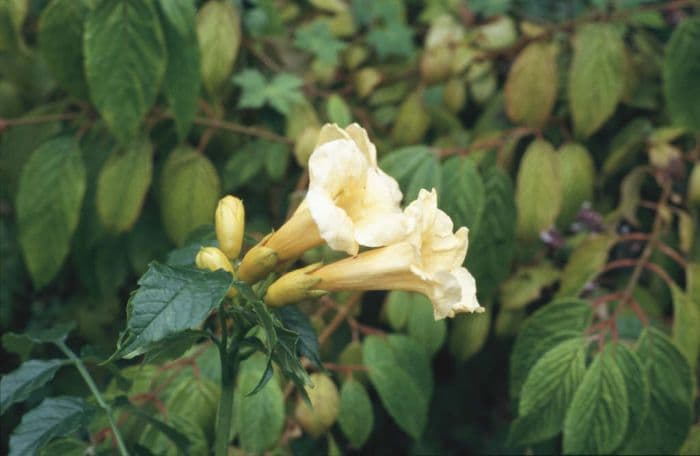
ABOUT
The commonly known Trumpet Vine has a striking appearance, characterized by its showy, trumpet-shaped flowers. This particular form, with its yellow hue, boasts vibrant and appealing blooms that are a warm shade of yellow, adding a splash of bright color wherever it grows. The flowers themselves are arranged in clusters, making a bold visual statement during their blooming season. The foliage of the Trumpet Vine is equally lush, with leaves that are compound, meaning they are made up of multiple leaflets spread out like fingers on a hand. These leaflets are typically a rich green shade, creating a dense canopy of leaves that can provide a decent amount of shade. The overall habit of the plant is to climb, and it is known to be quite vigorous in its growth, seeking out structures, like fences or trellises, to support its sprawling nature. The plant's climbing stems are sturdy, assisting it in attaching to various surfaces as it reaches upward and outward. Additionally, the plant is known for its adaptability, and these physical traits allow it to thrive in a variety of settings, covering ground and vertical spaces with ease. The intertwining of the stems gives it a somewhat tangled, yet robust appearance, embodying a kind of untamed beauty. With these characteristics, the Trumpet Vine is a favorite among gardeners looking to add a touch of the dramatic to their landscapes, its yellow flowers serving as a beacon to hummingbirds and other pollinators during the warmer months. Its hardy nature and attractive appearance make it a popular choice for those wishing to create natural green backdrops or living screens without concern for the garden's vertical limits.
About this plant
 Names
NamesFamily
Bignoniaceae
Synonyms
Yellow Trumpet Vine, Yellow Trumpet Creeper
Common names
Bignonia radicans, Gelseminum radicans, Tecoma radicans, Tecoma radicans f. flava, Campsis flava
 Toxicity
ToxicityTo humans
The most common common name for Campsis radicans f. flava is the Yellow Trumpet Vine. Members of the Campsis genus, including the Yellow Trumpet Vine, can be toxic if ingested. While it is not one of the most toxic plants, some humans may experience symptoms if they consume parts of the plant. These symptoms may include upset stomach, vomiting, and diarrhea. In some cases, more severe reactions such as difficulty breathing or an accelerated heart rate can occur, particularly if larger quantities of the plant are ingested. It is generally advised to avoid eating any part of the Yellow Trumpet Vine.
To pets
The Yellow Trumpet Vine, which is the most common common name for Campsis radicans f. flava, can also be toxic to pets if ingested. The plant contains compounds that can be harmful to animals. Symptoms of poisoning in pets might include gastrointestinal issues like drooling, nausea, vomiting, or diarrhea. More serious symptoms could entail a depressed central nervous system, leading to lethargy or incoordination. It is important to keep pets away from the Yellow Trumpet Vine to prevent the possibility of toxic ingestion. If a pet is suspected to have ingested part of the plant, it is advisable to seek immediate veterinary care.
 Characteristics
CharacteristicsLife cycle
Perennials
Foliage type
Deciduous
Color of leaves
Green
Flower color
Yellow
Height
30 feet (9.14 meters)
Spread
30 feet (9.14 meters)
Plant type
Climber
Hardiness zones
4-9
Native area
Southeastern United States
Benefits
 General Benefits
General Benefits- Attracts Wildlife: Campsis radicans f. flava, commonly known as Yellow Trumpet Vine, is known for attracting hummingbirds, butterflies, and other pollinators, which can help maintain a healthy ecosystem in your garden.
- Aesthetic Appeal: With its striking yellow trumpet-shaped flowers, the Yellow Trumpet Vine can add vibrant color and beauty to gardens, patios, and landscapes.
- Shade Provision: When grown over arbors or pergolas, the vine can provide cooling shade, making outdoor spaces more enjoyable during hot weather.
- Privacy Screen: The dense foliage and fast growth habit make it an excellent natural screen, offering privacy from neighbors or as a cover for unsightly areas.
- Erosion Control: The vigorous root system of Campsis radicans f. flava can help stabilize soil and control erosion on slopes or banks.
- Vertical Gardening: The vine's climbing habit makes it suitable for vertical gardening, allowing for creative use of vertical space in small garden areas.
- Wildlife Habitat: It can serve as a habitat for various species of wildlife, offering shelter and nesting sites for birds and other animals.
 Medical Properties
Medical PropertiesThis plant is not used for medical purposes.
 Air-purifying Qualities
Air-purifying QualitiesThis plant is not specifically known for air purifying qualities.
 Other Uses
Other Uses- The vines of Trumpet Vine can be used to create natural green screens or privacy fences when grown against a trellis or wire support.
- With its rapid and aggressive growth, Trumpet Vine can be employed for erosion control on slopes and banks, where it helps to stabilize the soil.
- The woody vines are sometimes repurposed in rustic arts and crafts, such as homemade wreaths or as part of natural wood sculptures.
- Trumpet Vine's bright flowers are attractive to hummingbirds, making it an ideal plant for designing a hummingbird garden.
- The plant can be trained to cover unsightly structures like sheds, garages, or chain-link fences, effectively softening the landscape with its lush foliage.
- Its ability to grow in tough urban environments is leveraged to create vertical gardens on concrete walls or along cityscapes.
- Landscape designers use Trumpet Vine in wild garden settings to provide seasonal color and attract a variety of pollinators.
- Birdwatchers might plant Trumpet Vine to attract not only hummingbirds but also other bird species that feed on the nectar or the insects it draws.
- In larger gardens and parks, Trumpet Vine can be used to create thematic garden sections, such as a 'bee garden', focusing on plants that benefit bees.
- The nectar-filled blossoms can serve as a natural food source for certain domesticated animals like goats which may browse on the vegetation.
Interesting Facts
 Feng Shui
Feng ShuiThe Trumpet Vine is not used in Feng Shui practice.
 Zodiac Sign Compitability
Zodiac Sign CompitabilityThe Trumpet Vine is not used in astrology practice.
 Plant Symbolism
Plant Symbolism- Inviting: Known as the Trumpet Vine, Campsis radicans f. flava is often found climbing the walls of buildings, which can symbolize a welcoming or inviting message, beckoning guests and symbolizing hospitality.
- Persistence and Perseverance: As a vigorous and hardy plant, the Trumpet Vine represents the ability to persist and thrive in difficult conditions.
- Attraction: With its showy flowers attracting hummingbirds, the Trumpet Vine is a symbol of allure and magnetism, possibly suggesting that the beholder has a naturally attractive personality.
- Connection and Reaching Out: The vine's growth habit of stretching out and clinging to surfaces may represent reaching out to others and establishing connections.
- Opportunity and New Endeavors: Its habit of climbing and finding pathways where there might not appear to be one can symbolize taking hold of opportunities or starting new ventures.
 Water
WaterTrumpet vine requires consistent watering to establish a deep root system, especially during its first growing season. Generally, an inch of water weekly, including rainfall, is recommended, which is equivalent to about 0.623 gallons for a typical garden plant. Once established, trumpet vine is drought-tolerant, and watering can be reduced. It's essential to water the plant deeply and less frequently to encourage root growth rather than shallow watering which can lead to a weak root system. During hot and dry periods, increase watering frequency to maintain the plant's health.
 Light
LightTrumpet vine thrives in full sun conditions, where it can receive at least 6 to 8 hours of direct sunlight daily. The best spot for the plant is an area that provides unfiltered sunlight for the majority of the day, as this promotes vigorous growth and abundant flowering. If you’re planting it near a wall or fence, make sure the structure faces south or west to ensure it gets enough sunlight.
 Temperature
TemperatureTrumpet vine is hardy and can survive in temperatures as low as -30°F. However, the ideal growing temperature range for this plant is between 60°F and 90°F. Trumpet vine can tolerate high summer temperatures well, making it suitable for many climates in the United States.
 Pruning
PruningPruning is essential for controlling the spread of trumpet vine and for encouraging healthy, manageable growth. The best time to prune is late winter or early spring, before new growth begins. Pruning can be done annually to shape the plant, remove any dead wood, and keep it from becoming invasive. Aggressive pruning is usually well-tolerated, so cutting back can be quite substantial if necessary.
 Cleaning
CleaningAs needed
 Soil
SoilYellow Trumpet Vine thrives in well-drained loam or sandy soil with a pH of 6.0 to 8.0. A mix of two parts loam, one part sand, and one part aged compost or manure will create an ideal growing medium. Ensure the soil mix is rich in organic matter to support its vigorous growth.
 Repotting
RepottingYellow Trumpet Vines are robust and can outgrow their pots quickly; they should be repotted every 2 to 3 years. Use a larger pot each time to accommodate the plant's fast-growing roots and to provide fresh nutrients.
 Humidity & Misting
Humidity & MistingYellow Trumpet Vine prefers moderate humidity levels, around 40-50%, which is often found in outdoor environments. Excessive humidity is not required and natural atmospheric conditions are typically adequate for its growth.
 Suitable locations
Suitable locationsIndoor
Provide strong light, prune regularly to manage size.
Outdoor
Full sun to partial shade, fertile soil, regular pruning.
Hardiness zone
4-9 USDA
 Life cycle
Life cycleThe Trumpet Vine (Campsis radicans f. flava) starts its life cycle as a seed, which upon finding suitable conditions, germinates and develops into a seedling. As the plant grows, it develops into a vigorous, woody vine that uses its aerial roots to climb over structures and other plants. The vine produces compound leaves and in summer, matures to yield showy, trumpet-shaped yellow flowers which are pollinated by hummingbirds and insects. Following pollination, the plant produces elongated seed pods that contain winged seeds, which are then dispersed by wind or gravity. In fall, foliage may turn yellowish before dropping, and the plant enters a period of dormancy during the colder winter months. With the return of warmer spring temperatures, the Trumpet Vine resumes growth from existing stems, completing the cycle.
 Propogation
PropogationPropogation time
Spring to Summer
The most popular method of propagation for Campsis radicans f. flava, commonly known as the Yellow Trumpet Vine, is through softwood cuttings. This method starts by selecting a healthy, young stem that has not yet hardened and is still in a stage of active growth. Cuttings should be made from 4 to 6 inches (approximately 10 to 15 centimeters) in length with at least two sets of leaves. The lower leaves are removed, and the cut end may be dipped in rooting hormone powder to encourage root development. The cutting is then placed in a well-draining potting mix or starting medium, ensuring good contact between the cutting and soil. The pot should be kept in a warm, humid environment with indirect light until roots have developed, which typically takes a few weeks. Regular misting can help maintain the required humidity levels for successful root growth.



